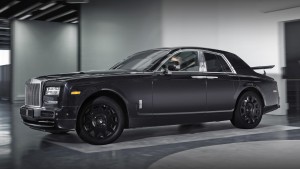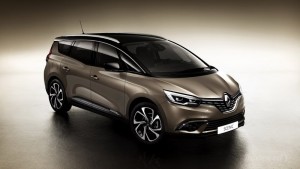Daily Archives: May 26, 2016
Rolls Royce’s SUV Is A Daily Car, Not A Monster Truck
There were rumors that Rolls Royce’s new 4×4 SUV was going to be a monster truck. Well, that couldn’t be farther from the truth. BMW’s design chief Adrian van Hooydonk said that it would be “daunting” to build an SUV for RR.
He promised in an interview though that Rolls Royce’s new 4×4 will be “a truly special car,” and that it won’t be a monster truck.
This is certainly good news for everyone who thought that RR’s Project Cullinan would be going toward the direction of building an SUV monster truck. Project Cullinan can be previewed through the Phantom prototype seen in these photos.
The “not monster truck” design has already been approved, and it will assuredly be one drivers can use as an everyday car.
Hooydonk explained that there are a lot of considerations need to be made when building a new model for RR. When the brand started, it had huge wheels that covered a lot of ground clearance because they were used by the Maharajas to travel from Europe to the Far East.
Back then, car companies have yet to categorize cars into sedans, SUVs or trucks. They were just cars, Hooydonk said. Roads back then weren’t smooth, too, so Rolls was built on that premise.
The idea for the new 4×4 is not to interpret the old Maharaja car. Rather, it will be built on the idea that RR cars were used for daily activities across rough roads.
What Hooydonk plans for the 4×4 is to completely move it away from the predicament RR has—that they are too elegant and too sophisticated to be driven. For this “SUV,” Royce wants something that drivers will want to use, instead of to look at only.
To do this, Rolls decides to sit the model on an all-new aluminum space frame structure, which is currently undergoing road testing to ensure a perfectly capable driving experience.
The result? Hooydonk hopes it’s an all-terrain SUV that is fun to drive every day, but not a monster truck, that has a likely V12 engine and the “magic carpet ride.”
Video: Japanese Police Gets The Nissan 370Z
There seems to be a pervading trend now among the governments of first-world nations: use sports car as the official livery of the country’s police force.
Just recently, Nissan handed over three of its 370Z to the Tokyo Metropolitan Police Department to show they are supporting the men and women in service of Tokyo, Japan.
The cars are all decked out in black-and-white regalia, complete with flashing lights and all the livery worthy of a police car. If one looks at the cars closely, they can also notice the Nissan badge at the front was replaced by the Tokyo police force’s shield.
Especially prepared by Nismo using the 370Z Nismo as donor, these three new police cars for the Tokyo Metropolitan Police Department will use Nissan’s familiar 3.7-liter V6 engine, based on a report. For these particular cars, the engine can deliver 350 horsepower.
Nissan provided the cars after the Tokyo Metropolitan Police Department called on Japanese automakers to provide them with an “iconic car” that will help represent the department’s commitment to road safety in the city (and even in surrounding areas).
This was a similar strategy used by the UAE government, particularly Dubai, although things are quite different in that oil-rich country. For the Dubai Police Department, nothing short of the priciest sports cars can speak out against the deluge of high performance engines parading around the city every single day.
Exotic cars such as the Bugatti Veyron and the Porsche 918 Spyder make up the Dubai Police Department’s fleet.
Such a call from Japan (and even from Dubai) followed an announcement by Italy’s Carabinieri earlier this month that it has a handful of Alfa Romeo Giulia Quadrifoglios in its fleet.
Can you just imagine having a Bugatti for a police car? The Nissan 370Z is not in any way cheap, but the Bugatti, Porsche and Alfa Romeo are on totally different platforms.
2017 Renault Grand Scenic Is Longer, Taller, Wider And Better
When Renault unveiled its Renault Scenic back in March, everyone was wowed as it was based on the R-Space Concept. Two months after, the company is pulling the sheet off its bigger brother—the longer, taller, wider and much better performer, the 2017 Renault Grand Scenic.
According to a source, the Grand Scenic is nine inches loner, almost an inch wider, and a half-inch taller than its smaller brother. It is a completely redesigned Renault Scenic—from the front end to the rear end. The result is a sexier compact MPV segment in the Grand Scenic.
Coming in as standards to the Grand Scenic are the 20-inch wheels, automatic emergency braking with pedestrian detection, full-color heads-up display, parking assistance, and diesel and two gasoline options.
It also has an all-new color that is exclusive to the Grand Scenic—the Vision Brown. Inside, it offers seating for five to seven people. They can enjoy the two-tone livery from the second equipment level up.
The exterior received major updates—new fascia, new headlamps, new grille and a redesigned hood. The windshield is also considerably longer and there corner glass panels before the side view mirrors.
But what gave the Grand Scenic a more elegant feeling is the 20-inch wheels with a twisted, five-spoke design. That certainly gives the Grand Scenic a more high-end appearance than the outgoing model.
Inside, nothing says spectacular than the Grand Scenic’s dashboard, corner glass that eliminates blind spots, and the cluster of tech such as an 8.7-inch touchscreen display, two USB ports, SD card slot, audio jack and 12-volt socket.
Renault also boasts of the car’s “Easy Life” sliding center console that allows a “saloon car cockpit feel” or a more open floor plan to make passengers more comfortable.
Pricing has not been released yet, but be ready to shell out £23,500 or $34,365 before options, taxes, and delivery.


